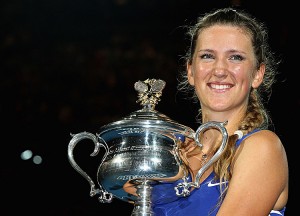Queen Victoria Azarenka: The New Novak Djokovic of the Women’s Tour?
Evidently, Victoria Azarenka finally got tired of waiting for her moment in the sun.
The new world No. 1 decided to take matters into her own hand in Melbourne—defeating both Kim Clijsters and Maria Sharapova consecutively to take the 2012 Australian Open crown.
Both her semifinal and final opponents had previously won the title “down under.” In fact, Clijsters was the defending Australian Open champion. Sharapova had won the title in 2008.
Azarenka’s win harkens back to the sudden rise of Novak Djokovic starting with the 2011 Australian Open when the No. 3 ranked Serb defeated No. 2 Roger Federer in the semifinals. Djokovic advanced to the finals where he defeated world No. 4 Andy Murray, claiming his second Australian Open title.
Djokovic had won his first Aussie Open back in 2008, again dismissing Federer in the semis. But after that lone slam victory three years ago—many feared the Serb would simply be another one-slam wonder.
Following his win at the 2011 Australian Open, Djokovic, of course, went on to win his next 43 matches, eventually losing in the semifinals of the 2012 French Open to Roger Federer. It took Djokovic until Wimbledon to overtake Rafael Nadal for the No. 1 ranking.
The Serb’s ascension marked the beginning of the Djokovic Era in men’s tennis and many predict the same sort of fortune for the newly crowned world No. 1 in women’s tennis.
The new top-ranked woman in the WTA is Victoria Azarenka, born in Minsk, Belarus.
Throughout her career, many compared Azarenka to long-legged tennis beauty Sharapova because both are tall and blond. Then, too, both ladies lay claim to high-pitched shrieks that accompany their explosive baseline bullets.
When Azarenka and Sharapova met in the final in Melbourne in 2012, the winner would find herself climbing to the coveted No. 1 ranking. This time, however, 22-year-old Azarenka proved her superior abilities on the tennis court as she destroyed the Sharapova game 6-3, 6-0.
Finally, there were no injuries or illnesses to bring collapse to the Azarenka game. Once the lady from Belarus got rolling, there was nothing Sharapova could do but try to hang on until the end as Azarenka dismantled the Russian’s game.
Probably, there is no need to point out that this is the fifth grand slam women’s title in a row with a different winner. Clijsters won the 2011 Australian Open while Li Na of China won the French title later that spring.
Petra Kvitova emerged as the surprising winner over Sharapova in the 2011 Wimbledon final—only to be followed by Samantha’s Stosur’s stunning upset win over Serena Williams to capture the 2011 US Open in Flushing Meadows. Now, Azarenka has captured the 2012 Australian Open championship—her first slam title.
What does it mean?
For one thing it means that there is no clear front-runner for the ladies. Following Serena Williams’ injury after capturing the 2010 Wimbledon title, Kim Clijsters seemed destined to take over the No. 1 spot in women’s tennis. She won the 2010 US Open and then the 2011 Australian Open. Injury after injury, however, blighted the Belgian’s sojourn to the top. Now, Clijsters hints at retirement once again.
Justine Henin, who once reigned over women’s tennis, came back briefly in January of 2010 only to leave the game abruptly a year later. Henin suffered from a fall at 2010 Wimbledon that ruined her right elbow, eventually rendering her unable to compete. Henin had first shocked the tennis world by her retirement in 2008 just prior to the French Open where she was favored to win.
At age 30, Serena Williams will never be the force she once was in women’s tennis, although she has not quit competing. No doubt we will see the younger Williams sister capture another major title. Venus Williams, on the other hand, is just lingering on the edge trying to decide the best time to leave the professional game altogether.
Sharapova, who made two finals in the past year, does not appear to have the ease of movement or the precision necessary to win the big clutch matches—although you cannot discount the Russian altogether because Sharapova never shies away from a challenge.
Wozniacki, who held the No. 1 spot for well-over a year, has never won a major nor has she reached a slam final since the US Open in 2009. Even though her consistency of play kept her at the top for a long while, Wozniacki does not have “game enough” to win a major.
The question remains—can she develop a weapon that will allow her to win? As a counterpuncher, so far, the answer is no.
When there is no clear cut favorite or even stability among the top three or four—as in the men’s game—the perception of the public is that the women’s game is in chaos.
Fans like predictability. They like pulling for or against a favorite and right now the women’s game does not offer them that platform.
The truth is—it is a very exciting time in women’s tennis as the young guard moves up and over the old guard. That is not to say that Clijsters, Li Na, Stosur or Serena Williams are finished—they are not by any stretch of the imagination. But there are some new, exciting young players who are fine-tuning their games and pushing their way into the winners circle.
Azarenka is the latest. But prior to Queen Victoria’s Aussie Open win, there was Petra Kvitova who won the title at the All-England Club and, no doubt, there may be a young German joining them soon like Andrea Petkovic, Sabine Lisicki or perhaps even Julia Goerges.
It appears, however, that Azarenka has the best chance of becoming the “Djokovic” of the women’s game now that she has learned to control her emotions on court. With her superior speed, court movement and aggressive play, Azarenka should become the woman for all seasons and all courts. She has the ability to win on any surface.
Just an inch shorter than six feet, with a powerful two-handed back hand, Azarenka has been improving steadily since she turned pro in 2003. She was named the junior world champion in 2005.
Azarenka won her first tournament in 2005, defeating Viktoriya Kutuzova in the finals of the ITF Roller Open in Luxembourg. Remarkably talented, her ranking continued to climb as the level of her play improved.
Early on, Azarenka had a reputation for crumbling at the end of matches, blowing huge leads and wilting under the pressure. The meltdowns were products of a lack of both physical conditioning and mental toughness.
Azarenka also had a fiery quick temper. Her shrieking, temper, and attitude did not win her many fans or add to her success.
As a growing teenager, she had issues with fitness because of illness and injury. She hired a fitness coach, Pat Etcheberry, to oversee her conditioning. He worked with her prior to the 2008 season.
The hard work is now paying off, and Azarenka now has a firm grasp on her temper, mettle, and her ever-improving game.
Her chief competition should come from world No. 2 Petra Kvitova whose win at Wimbledon in 2011 shot the Czech into the spotlight. Certainly Kvitova has the superior serve plus a blistering forehand but her best surface may be grass and not the hard courts—at least, not yet.
Then too, the spotlight is new and seemingly unwelcome in the Czech’s world and it may take Kvitova some time to adapt to such high expectations. Some players like Dinara Safina never could overcome their fears—playing not to lose rather than playing to win.
For anyone to have a season like Djokovic did last year is highly unlikely. But the task of cementing the No. 1 spot may be settled if Azarenka can continue to play with aggression, self-assurance enhanced by brilliant footwork and shot selection.
We will be expecting much from Queen Vicki….
















